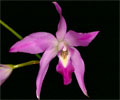|
|
|
|
|
| |
Flasks of
Laelia autumnalis 'MC4504' × sib 'MC4506' |
|
| |
|
|
| |
| Number: |
TN6373 |
| Name: |
Laelia autumnalis 'MC4504' × sib 'MC4506'
|
| Type: |
sib (What's that?) |
|
Click to Enlarge

Pod Parent Flower |
Click to Enlarge

Pod Parent Closeup of Flower |
Click to Enlarge

Pollen Parent Flower |
Click to Enlarge

Pollen Parent Closeup of Flower |
|
|
|
| |
Comments: Pod parent plant: One of the offspring from our TN1818 effort of 2000.
Pollen parent plant: One of the offspring from our TN1818 effort of 2000.
For additional origin/habitat information supplied courtesy of
Charles and Margaret Baker, see further below, near the bottom of this page.
|
Temperatures we attempt to use in the lab & greenhouse:
| For Species: |
|
Summer, Spring, Autumn: days average 77°F, nights 53°F; best fit is Cool-Intermediate 75-58°F
(Source:
Baker's Web OSC) |
| For Species: |
|
Winter: days average 72°F, nights 40°F; best fit is Cool-Cold 64-44°F
(Source:
Baker's Web OSC) |
|
About the name...
| Etymology of |
autumnalis |
|
From Latin "autumnalis" flowering in the Autumn.
(Source:
Mayr & Schmucker 1998) |
| Etymology of |
Laelia |
|
One of the vestal virgins, Laelia.
(Source:
Pridgeon 1992) |
| Pronunciation of |
autumnalis |
|
aw-tum-NAH-lis
(Source:
Hawkes 1978) |
| Pronunciation of |
Laelia |
|
LAY-lee-ah
(Source:
Pridgeon 1992) |
|
If you would like to direct someone to this web page, please copy and paste this URL into your email:
http://troymeyers.com/d?016373
| Flask Information |
| Availability: |
We have sold all of the flasks for this item. |
| You should: |
Consider getting individual plants or compots instead of a flask.
You can place a "Notify Flask Recipients" Request, and either we or a flask recipient may contact you when plants are available.
You may also place a "Notify Retries" Request, and if an identical pollination (the same parents) is done again, we'll let you know.
You may reserve a flask, but it's very unlikely you'll get one ...this could only happen if we found a flask that we didn't know we had. |
| Yield Estimate: |
788 plants (based on flask surveys done 08/14/2008 through 04/08/2011)
|
| Plantlet Sizes: |
From many flasks 30 - 120 mm plants (based on flask surveys done 01/05/2009 through 07/20/2011)
From one most recently surveyed flask 60 - 100 mm (07/20/2011)
|
|
You might also want to:
|
View the seed assay for this item.
View items of the same species.
View items of the same genus.
|
| Ordering Information |
| You are not currently logged in. |
|
You must be a registered user and be logged in to reserve a flask or place a notification request. Please log in:
|
|
|
|
|
|
| |
The origin/habitat information below is supplied courtesy of Charles and Margaret Baker
The following information is based on the name of the plant provided by the donor, and assumes that the name is correct. If the plant has been misidentified, then the following information may not be correct.
This text is copyrighted by the Bakers and may not be reproduced without permission.
ORIGIN/HABITAT: Mexico. The type specimen was found near Morelia in the
state of Michoacán. Plants are now known to grow in the Pacific-facing
mountains of central Mexico in the states of Nayarit, Jalisco, Colima,
Guanajuato, Guerrero, México, Michoacán, Morelos, and Puebla. They are
found in open, dry or humid, deciduous or evergreen forests of oak or oak
and pine at 4600–8850 ft. (1400–2700 m). Plants usually grow on scrubby
oak trees in exposed locations, but they are sometimes found on mossy
rocks.
More about this information and the Bakers...
|
|
|
| |
|
|
|